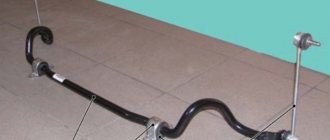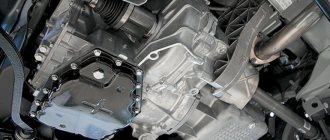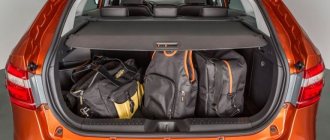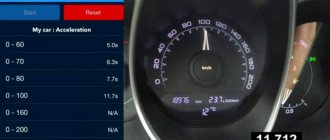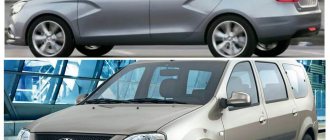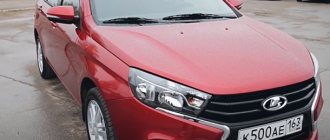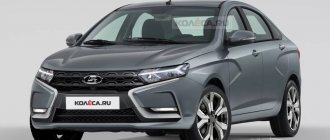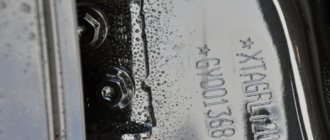Lada Vesta belongs to the B-class and is the long-awaited product of the Volga Automobile Plant, which, according to the original plans, meets all the requirements for a modern car. The body of the Lada Vesta received a recognizable silhouette due to the dark radiator grille, characteristic side triangular stampings on the body and high-cut side windows. The palette of colors offered is also well-developed, including quite bright ones, which are very popular with the young and ambitious.
As for the interior decoration and equipment of the cabin, which directly affect its interior, the plant has practically not deteriorated its design compared to concepts and prototypes. At the same time, literally all components of the interior use new items that were previously absent from the Lada, significantly increasing the consumer value of the car and making its operation much more convenient.
Serial photos of Lada Vesta from the plant in Izhevsk
We have already reported more than once about receiving photographs from the plant in Izhevsk. So, in order, what we have.
Workers managed to capture one of the first assembled versions, which stood in the workshop in Izhevsk to be shown to managers
Back view. Someone even sits inside the cabin and looks at the new product
After a while, the management of AvtoVAZ and IzhAvto decided that it was time to “warm up” the audience a little and posted an official photo.
But recently we managed to get pictures of the Lada Vesta painted in new colors.
Photo of a car in Mystery color
“Lux” package. Lemon color. A very bright and unusual color for Lada. We think that young girls (and some guys) are the target audience for this color
Also an interesting “youth” color called “Amethyst”
photo of a manual transmission knob
This is what the handbrake of the future new product looks like
Photos of Lada Vesta
Exterior photo of Lada Vesta - appearance
From the outside, a sharp transition from the old school of design to the new one, led by Steve Mattin, is immediately visible. He managed to turn the familiar and discreet VAZ into a stylish and extravagant car that makes people turn around on the street.
Interior trim and ergonomics
The soft surfaces of the Lada Vesta interior are finished with fabric and leather, as well as soft-look plastic, which visually resembles soft leather, but is sufficiently hard to the touch. The surface of the plastic is embossed, giving the interior a strict appearance. The quality of finishing materials is quite consistent with the price class to which the Lada Vesta belongs.
To decorate the interior of the luxury package, chrome inserts are used.
Improving the aesthetic parameters of the seats is achieved by using gray inserts in their upholstery, photo below:
From an ergonomic point of view, the interior of the Lada Vesta is designed like a car of an older class. The controls and monitoring instruments are located very well, and the indicator readings are read quickly and accurately.
Photos of Vesta front part
Naturally, the full face of the model deserves special attention. The massive black radiator grille with a pair of horizontal bars, in the middle of which sparkles the company’s nameplate, immediately catches your eye. And immediately below it, as if continuing the composition, is the central part of the front bumper, made in a similar style and playing the role of an air intake. Interestingly, this black section narrows in the middle and widens on the sides, creating the silhouette of the letter "X". It was not for nothing that it was said that Lada Vesta adopted the basic ideas of the LADA X Ray concept.
Photos of the Lada Vesta interior
The interior of the Lada Vesta has long been exciting the minds of its fans. Assumptions are made, heated debates flare up, etc. The main topic of recent debates on forums and in the Lada Vesta Club were photos from the concept - potential owners of the car discussed how the interior of the production Vesta would correspond to the one presented at the auto show. Scroll to the end - you will see a photo of the interior of the serial Lada Vesta !
Of course, there was information from Mikhail Ryabov, who holds the post of director of OAS LLC, who claimed that there would be no serious differences, and all the main points from the concept would be transferred to the production model. And so, on July 20, 2014, Bu Inge Andersson presented another teaser with photos of the interior in Samara. One of them showed a clear and detailed image of the model's interior. From this photo you can determine the main points.
Photo of Lada Vesta steering wheel
Finally, LADA has acquired a multi-steering wheel - an option that has long become familiar to foreign cars. From now on, the Vesta driver will be able to pay more attention directly to the road, without being distracted by the center console in search of the necessary regulator or key. The steering wheel now has control buttons for the audio system, cruise control, speakerphone, and the option of heating the steering wheel.
In addition, the steering wheel itself is made in a 3-spoke version, with a sporty style and aluminum inserts. It is plump, making it fit comfortably in your hands. And the materials have become noticeably better quality.
Dashboard
It was not for nothing that there was talk that when creating Vesta, Asian trends were taken into account. So the dashboard looks like some kind of symbiosis between those of Solaris and Rio. The tidy flaunts spectacular wells, in the depths of which scales, made in the style of infographics and with poisonous green backlight, are buried. Looks very stylish!
There is a large speedometer in the center of Vesta’s dashboard, the tachometer is to the left, and on the right, the designers have allocated space for analog indicators of temperature and fuel levels.
checkpoint
The Lada's robotic transmission selector is designed quite elegantly, but some may find its pale white hue against the background of the black center console to be tacky. Like other models, this box has both automatic and manual modes.
Regarding the demonstration of the machine “in action” in front of the paparazzi, the show is planned for the beginning of August.
Electrical package
The entire unit, which is responsible for the operation of not only the power windows, but also the glass locking and heated side mirrors, is located on the driver's door. The block is designed in a new style and turned out very nice.
Power window control buttons Lada Vesta
Armchairs
There has also been significant progress in this regard. It is clear that the designers focused on creating high-quality lateral support bolsters, since in previous models there were widespread complaints about the looseness of the seats.
The new Vesta seats hold the driver’s body much better, which is especially noticeable when cornering. In addition, higher quality and more expensive finishing materials began to be used for upholstery.
Climate control unit
AvtoVAZ designers did a great job - externally the control unit looks stylish and elegant, in no way reminiscent of a thoughtless accumulation of keys. And there are no problems with ergonomics. A pair of dials are located at the bottom of the center console, and between them there is a small screen on which all data is displayed. Immediately above them are the electronics control keys.
If you visually evaluate the optional set, then Vesta will probably acquire a stability control system (with the ability to turn it off), a heated windshield and a heated power unit.
Multimedia
The multimedia system screen will be located in the center of the console, surrounded by air deflectors. Regarding the controls, most likely it will be created using touchscreen technology, but duplicate keys will be located on the steering wheel.
As for the functionality, it will be very impressive - it includes a phone, music, navigation, and radio. In addition, according to sources, it is possible that Vesta will even get access to the Internet.
Profile - side view
A photo of the Lada Vesta from the side no less expressively demonstrates the beauty of the new product. In general, the side part is made quite utilitarian - the roof is slightly tilted back, the doors are medium-sized, the feet climb onto the rear fenders. All this is familiar from a lot of other models. But the highlight lies in the expressive curves made in the shape of the same letter “X”. In the photo it is noticeable that the sides “begin” on the front and rear wings, and the curves run along the front and rear doors, respectively. These stampings are made very clearly.
Exterior review of Lada Vesta
The appearance of the car was developed with the help of foreign designers, and this is clearly visible in the front part. It has its own style, especially in comparison with other, earlier AvtoVAZ car models, where the design was, to put it mildly, far from the best. There is a stamping on the sides that resembles the letter “X” in shape. The rectangular fuel tank hatch does not fit into the curves of the body at all, but this is not very noticeable. From the rear, the car also looks modern.
Headlights, inscriptions, chrome - everything is at the level of classmates. The body length is 4410 mm, width is 1764 mm, which is slightly larger than that of the same Kia Rio or Hyundai Solaris. The wheelbase is also slightly superior and amounts to 2635 mm.
Lada Vesta review - engine, chassis and gearbox
The 1.6 liter engine has a power of 123 hp. s., which is at the level of cars of this class. The dynamics suffer a little against the background of the robotic gearbox. The handling is soft, the car clearly responds to steering turns. Experts call Vesta's steering one of the best in its class.
The chassis assembly allows you to fully enjoy steering even on the worst roads.
Salon Vesta SV
It is distinguished by poorer colors, for example, the SW station wagon does not have orange. Otherwise, the interior of the station wagon is similar to the cross.
Photo of SV salon
Photo of the interior of the sedan modification
Inside the Lada Vesta car, materials and innovations were used that had not been used on a vase before. This made overall operation more pleasant for people; for the first time on a vase, the steering column could be adjusted for reach and installation angle. The steering wheel can be adjusted for reach by 50 mm and angle by 7 degrees. Vesta now has a multifunction steering wheel, which was not previously available on any VAZ model. The steering wheel has a three-spoke badge in the middle, it looks made with high quality and accuracy! The steering wheel has control buttons for the cruise control radio and telephone.
The instrument panel is interestingly implemented; it is grouped into three wells, all of which resembles a sports car. The quality of the panel material is good. The panel has few lamps, but despite this it looks informative. The torpedo is made of dark plastic. The center console is level with the panel, but protrudes forward a little and this is convenient for use; you don’t need to reach out to press a certain button. The console is divided into two parts, but depending on the configuration, it is located on top (in the expensive configuration there is a multimedia system with a 7-inch screen), and a branded radio in the cheaper basic version. On the second part of the panel there is a climate system separated by a row of buttons. The central tunnel is equipped with two cup holders.
The car has good visibility; the arches do not interfere with the view, as on the previous model 2170. Two airbags are built into the front panel (driver plus passenger). Regarding the interior trim, it looks high quality. The door cards, by the way, use new Soft Look plastic, are visually similar to leather. The plastic is embossed and hard to the touch. Despite the cheap materials, the interior looks quite strict and not childish, and if the car is in the Luxury configuration, the interior is equipped with additional chrome inserts. In general, Vesta’s interior looks a class higher than it is: ergonomic seats with good upholstery, all instruments and elements are arranged thoughtfully. When you get into the car, it’s pleasant to be in, you can see the road, and it’s easy to read the information on the speedometer. The seats have a high depth of adjustment, which allows tall people to feel comfortable behind the wheel. In previous models, there was limited space in the back, which was a big minus. There is ample knee room behind the driver; the distance from the rear sofa to the front seats is 226 mm. In general, it feels like the dimensions inside the car have been thought out. The seats are comfortable, the headrest follows the lines of the body and is friendly with the back of the head when standing in a traffic jam. The distance from the floor to the rear sofa is 345 mm, and from the floor to the top of the front seats is in the range from 276 to 310 mm. The distance from the floor to the steering wheel (since it is adjustable) is from 450 - 528 mm.

